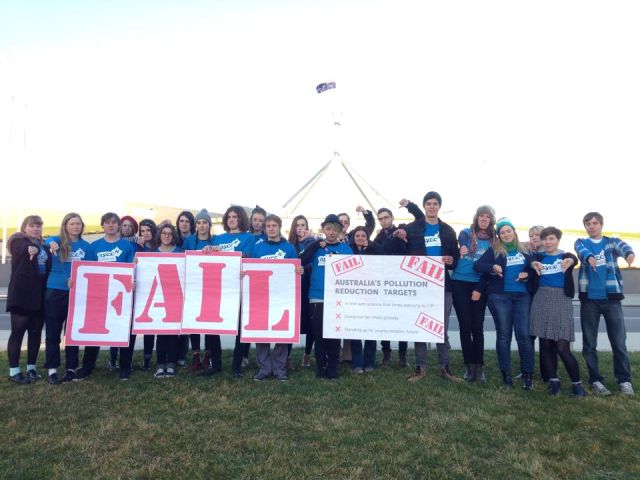
The federal government has been widely criticised for its weak carbon emission reduction target announced on August 11. The new target of reducing emissions by 26 to 28% on 2005 levels by 2030 will replace the previous target of a 5% emissions reduction on 2000 levels.
These targets are nowhere near enough to stay under a 1.5°C rise in global temperature, needed to prevent going over climate tipping points.
NSW Greens MLC Mehreen Faruqi said: “[Prime minister Tony] Abbott’s plan is a recipe for disaster for NSW and the world. Australia’s reluctance to do anything meaningful to reduce greenhouse gases will mean the worst case scenario predictions of climate change impact come ever closer.”
The Climate Council said the targets “fall short of the science, they fall short of global action and they fall short of what’s necessary to protect Australians from the impacts of climate change”.
It recommended a target of 45 to 65% reduction (or 40 to 60% on 2000 levels) to avoid runaway climate change.
Moving the target to a baseline of 2005 makes it easier to compare to targets set by the US and Europe, but it was also a year when emissions were at a historic high.
The US, EU and Canada recently adopted targets of cuts between 30 to 38% on 2005 levels. Although stronger than Australia, these targets also fall far short of what is needed.
In the context of other industrialised countries choosing stronger targets, the government knew it had to raise its targets to strengthen its position at the UN climate talks in Paris at the end of the year.
But it is doubtful it has any intention of implementing them. New research shows that the government’s own climate change policy is not up to the job of achieving even these weak targets.
Energy market analysts RepuTex found that under the government’s “Direct Action” plan, pollution from the top 20 largest emitters will be allowed to rise. Some of Australia’s dirtiest coal-fired power stations, including Loy Yang A and B, Hazelwood, Bayswater and Yallourn, are not expected to be forced to reduce their emissions under the scheme.
The report described the “safeguard mechanism” — promised as a way to ensure cuts from one sector do not end up being displaced by rises elsewhere — as a “toothless tiger”.
This is because when emissions baselines are set on July 1 next year, they will be set at the highest point of emissions an individual company has reached over the past five years. This gives companies a significant amount of room to increase their emissions, penalty free.
At the same time, the government has been attacking the renewable energy industry. In recent months it has ordered the Clean Energy Finance Corporation to stop investing in wind and solar energy; appointed a “wind commissioner” to investigate complaints about wind farms; and promised climate sceptic Bjorn Lomborg $4 million in public funding to set up a centre at the University of Western Australia (later withdrawn after protest).
This attitude, along with its steadfast support for new coal projects, is becoming increasingly out of step with public opinion.
New polling commissioned by the Climate Institute and released on August 10 shows 63% of Australians believe the federal government should take climate change more seriously, an increase of 6% since last year.
Support for renewables has soared: 84% said they preferred wind and solar power among their ideal energy mix and only 21% supported gas. Coal is now tied with nuclear as least preferred option at 13%.
Similarly, 65% of respondents think that reducing investment in wind farms and household solar power is the opposite of what is needed, and 72% think “governments need a plan to ensure the orderly closure of old coal plants and their replacement with clean energy”.
It shows that attempts by the government to limit the development of renewable energy is deeply unpopular.
This polling indicates support for climate action has risen significantly compared with similar polling in 2012 when enthusiasm for the key plank of the Labor/Green government’s climate policy — the carbon price — slumped amid the Coalition’s fear campaign.
The carbon tax was eventually defeated but the issue of climate change is not going away for the government. Of the 70% who believe that climate change is occurring, 93% think that Australia is already feeling the impact, indicating that people are taking notice of increasingly severe bushfires, flooding and storms.
The polling also found that most people believed Labor’s promise to reintroduce a carbon price would “just increase electricity prices and not do much about pollution”.
Experience from Europe shows that a carbon price or emissions trading scheme is not the solution for quickly driving the deep cuts we need.
The highest reductions in Australia’s emissions have come from energy efficiency programs and a shift in the source of electricity generation.
Some of the most successful policies, such as the Renewable Energy Target and subsidies for household solar, were scrapped or weakened by Abbott. These should be reinstated and extended to allow public investment in large-scale renewables.
This shift to renewable energy also requires a moratorium on all new coal and unconventional gas projects, and the replacement of old coal power plants with solar thermal technology.
Like the article? Subscribe to Green Left now! You can also like us on Facebook and follow us on Twitter.